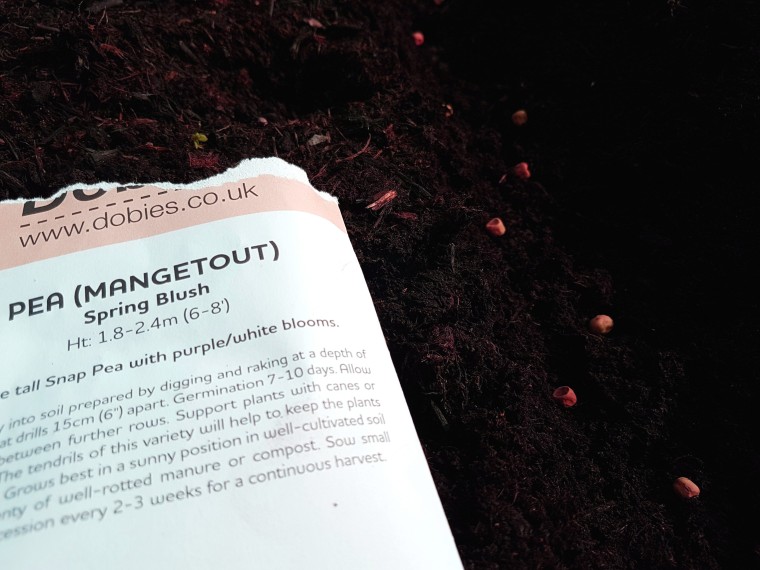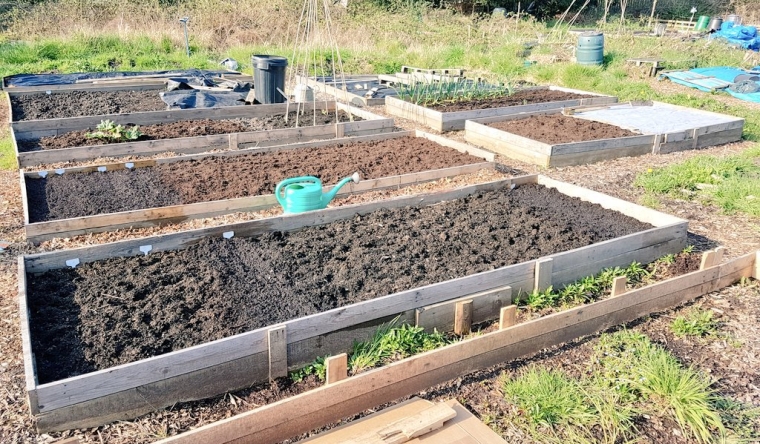Where has the spring been?
After the snows of March, the rains that followed and for me, a brief but beautiful holiday in the sun, I’ve felt behind in my plans and activities on the allotment garden.
There has been sporadic gaps in the miserable weather where I’ve thrown on my wellies and nipped to the plot, but then a bumper spring Saturday arrived. The sun shone, the T-Shirt was on and I even broke a sweat.
A few weeks ago, I wrote a blog post about the importance of sharing our allotment gardening stories. There’s a fantastic community of allotment holders and kitchen gardeners online and our stories are hugely important to inspire, support and encourage others to take up an allotment or kitchen garden and enjoy all the benefits they provide.
The two years on the allotment has had its highs and lows. I often wonder if I should be further down the line with the cultivation of the entire plot. However, the overgrown, Mares-tail ridden garden that loves to flood in the winter has come a long way. And, I have so much more to create, build, grow and importantly enjoy.
The sun is still tickling my skin and there’s a big spring in my gardening step. Here’s a little view from the Sharpen Your Spades plot.

Construction
Build beds
Despite delays elsewhere, improving the existing raised beds and building new ones is a task I have managed to get on with.
I didn’t want raised beds when I took on the current plot. However, they are a necessity against the floods suffered by our allotment site. I’ve come to terms with having raised beds and have since discovered the benefit they provide.

Improved paths
Combined with the raised beds, the dug-out paths backfilled with woodchip have prevented the problems with flooding and made maintenance much easier. However, they don’t prevent the indestructible Horsetail from rearing its head. This year, I’ve decided to lay permeable weed membrane over the paths and cover with fresh woodchip as a means of tackling the problem and make maintenance even easier.
You can turn woodchips into compost. The benefit of woodchip paths is they rot down perfectly well on their own and turn into surprisingly nice organic matter. A number of plot holders on the site dig the paths out every few years and use the material to top up their raised beds or fill new ones.
Sowing and Planting
Shallots
The shallots are in. They are a fantastic ingredient for the kitchen and I’m surprised this is the first year I’ve grown them.
I’ve had the urge to grow my own onions to pickle and provide for the table over the Christmas period for quite a while, but I’ve found choosing a suitable variety to make the large, crisp pickled onions I love has been tricky. I’m growing this crop of shallots to see if they make good pickled onions.
Potatoes
The seed potatoes have been screaming at me to put them in the ground. Finally, the job is done and I’m already licking my lips at the prospect of beautiful new Charlotte potatoes, dripping in butter as a delicious summer treat.


Potatoes are the only crop I’ve grown not using a no-dig approach. I’m not sure why as its absolutely possible. I’ll look to make the move next year.
Rhubarb
The rhubarb is teasing me. I’ve watched with jealousy the photos on Instagram and Twitter from others enjoying their first rhubarb harvests of the year, dreaming of crumble. My rhubarb is poking its head above the soil, whispering taunts and yawning lazily.


It’s worth the wait. I have two varieties, Raspberry Red and the popular culinary choice, Valentine.
Radish
Radish is super-fast food from the plot. If things had gone to plan and I’d sown earlier, the first radishes would almost be ready for plucking.


I’ve sown a few short rows of two different varieties. Mr Fothergills Sparkler 3 has an attractive bright red colour with a white tip, a crisp texture and peppery flavour.
From Rob Smith’s Heritage Range, an old Italian variety called Giant Butter. This crimson-skinned radish will grow to around 5cm in diameter without becoming woody in texture.
I’ll sow again in a week or two to enable a succession of tasty radishes to liven up a salad in the latter part of the spring. Yum!
Onions
Finally, the onion sets are in the ground. I had a bumper crop last year and they are still providing for the kitchen. I’ve decided to grow less in 2018, they store fantastically well, but I want to grow less but more varieties of crops this year.

Last years onions drying out
Peas
Last year, the peas were a huge success. I’m excited to try two different types and varieties on the allotment in 2018. I want crops that excite, look good and taste delicious.
The peas I’ve sown have been provided by the lovely people at Dobies.
Spring Blush is a tall-growing, high yielding mangetout. It looks incredible with bi-coloured purple and pink blooms and lots of rose blushed and green pods.
I can’t wait the see Champion of England grow. Another variety from Rob’s Heritage Range, this will grow up to 8ft tall and provide lots of large pods containing 7-10 sweet peas inside. What a show!

Carrots and Beets
Also over the weekend, I’ve sown a row of Bull’s Blood beetroot and a row of Speedo F1 carrots. I still need to get my parsnips in the ground!
I’ll sow more Boltardy, because it’s just so good and continue sowing the root veg for successional harvests over the months to come.
I’m thrilled to finally get some wonderful crops sown on the allotment. I think we can safely say spring has arrived.
I feel incredibly motivated and excited for the growing season in 2018. I have so many plans to develop the plot this year and I look forward to sharing them with you too.

How is your allotment and kitchen garden looking? Have you sown many seeds yet? I’d love to hear what’s going on with your plots. Let me know in comments below or come join me on my Facebook page.
If you enjoyed this post, I’d love if you would share it using the buttons below.
Follow Sharpen Your Spades! You can receive my posts by email – Subscribe here.
Follow me on BlogLovin.
You can get in touch with me here.



Love the sound of Spring Blush peas! Great blog post 😍👏🏼☀️
LikeLiked by 1 person
Thanks Eleanor. They do don’t they. They look so wonderful. I’m sure my daughter will be thrilled too. Cant wait to see them bloom and crop.
LikeLike
It is good to see that more of us are growing rhubarb again! I still have the same rhubarb that I grew when I was a kid. I do not know what it is, but it is my favorite.
LikeLiked by 1 person
Yeah I think it’s making a come back for many people. Even those who don’t garden. It such a brilliant crop. No maintenance and some fantastic varieties
LikeLiked by 1 person
There is a bit of maintenance. Rhubarb must be made into pie!
LikeLiked by 1 person
Your plot looks fab. Especially in the sun.
LikeLiked by 1 person
Thanks so much Ali. It’s getting there. So much more space to use but I’ve focused on getting this section right, manageable and productive. I’ll move onto the next stage later this year. Sun makes everything better doesn’t it? 🌞
LikeLiked by 1 person
I think the sun made such a difference to the plot and my mood too!
LikeLike
Your plot looks terrific, and you are WAY ahead of us. The shallots are in, along with first peas, some onion sets, carrots, and some purple pak choi. That’s it…much behind “normal.” Last year, I used lots of my decomposing wood chip path material to top off beds and mulch new plants. Unfortunately, apparently it was loaded with pill bugs or sow bugs…I need to look up which are the ones that are supposedly “good” and which are “bad.” Mine are the bad, because during the night they would eat all the petals on the violas and other veggies. At first I assumed it was slugs, but trips out with a flashlight proved it was the roly-polys. ALso, may I suggest that you double layer the weed barrier before putting down mulch. I put down a single layer of “25 year” and the dratted grass had no trouble rooting through it. A double layer seems to be working. Keep up the good work. Great progress & great posts.
LikeLiked by 1 person
Aww thank you so much. I’m happy how things are looking and I’ve so much more space to use and create too. It’s been a tough spring hasn’t it and I think many serving the same position. Well, I’m hoping we are over the hump and we can get going! That’s a useful tip. I’ll double layer!
LikeLike
Looks great and you’re ahead of me! I only got the carrots in a few days ago and still haven’t planted beetroot or potatoes and now the weather seems to have done a U-turn. Lots of seedlings bursting out of pots though which I’m looking forward to planting. I also really want to start a no-dig approach, at least with some of the plot, so I need to look into that instead of just going with what I know – thanks for the inspiration.
LikeLiked by 1 person
I highly recommend the nodig. I was so impressed woth the beds I used the approach on last year. Now all but my potatoes are nodig and it’s saved me so much time. Good luck.
LikeLike
I have just planted my first rhubarb crown after is was liberated from a local nursery where my neighbour works. Get in! A long while until the first harvest but planning ahead. I have planted, so far, the first of my 76 various spud tubers this year but a good few to go yet. Great looking plot.
LikeLiked by 1 person
Thank Louise. I have so much left to play with and create too. Nice work on the rhubarb 👍 76?? Wow! You must have a football field to work with!
LikeLike